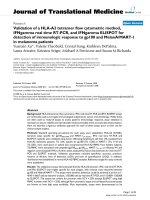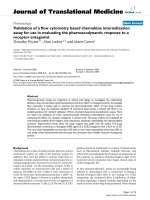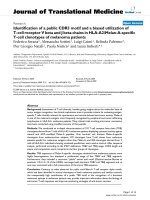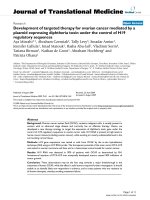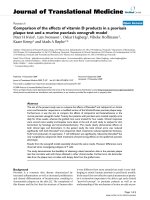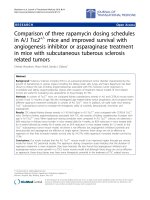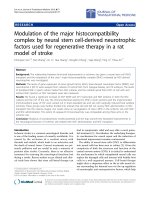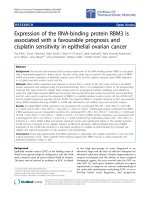báo cáo hóa học: "Design of a complex virtual reality simulation to train finger motion for persons with hemiparesis: a proof of concept study" docx
Bạn đang xem bản rút gọn của tài liệu. Xem và tải ngay bản đầy đủ của tài liệu tại đây (971.82 KB, 10 trang )
BioMed Central
Page 1 of 10
(page number not for citation purposes)
Journal of NeuroEngineering and
Rehabilitation
Open Access
Research
Design of a complex virtual reality simulation to train finger motion
for persons with hemiparesis: a proof of concept study
Sergei V Adamovich
1,2
, Gerard G Fluet*
2
, Abraham Mathai
1
, Qinyin Qiu
1
,
Jeffrey Lewis
1,2
and Alma S Merians
2
Address:
1
New Jersey Institute of Technology, Department of Biomedical Engineering Newark, NJ, USA and
2
University of Medicine and Dentistry
of New Jersey, Department of Rehabilitation and Movement Science, Newark, NJ, USA
Email: Sergei V Adamovich - ; Gerard G Fluet* - ; Abraham Mathai - ;
Qinyin Qiu - ; Jeffrey Lewis - ; Alma S Merians -
* Corresponding author
Abstract
Background: Current neuroscience has identified rehabilitation approaches with the potential to
stimulate adaptive changes in the brains of persons with hemiparesis. These approaches include,
intensive task-oriented training, bimanual activities and balancing proximal and distal upper
extremity interventions to reduce competition between these segments for neural territory.
Methods: This paper describes the design and feasibility testing of a robotic/virtual environment
system designed to train the hand and arm of persons with hemiparesis. The system employs a
simulated piano that presents visual, auditory and tactile feedback comparable to an actual piano.
Arm tracking allows patients to train both the arm and hand as a coordinated unit, emphasizing the
integration of both transport and manipulation phases. The piano trainer includes songs and scales
that can be performed with one or both hands. Adaptable haptic assistance is available for more
involved subjects. An algorithm adjusts task difficulty in proportion to subject performance. A proof
of concept study was performed on four subjects with upper extremity hemiparesis secondary to
chronic stroke to establish: a) the safety and feasibility of this system and b) the concurrent validity
of robotically measured kinematic and performance measures to behavioral measures of upper
extremity function.
Results: None of the subjects experienced adverse events or responses during or after training.
As a group, the subjects improved in both performance time and key press accuracy. Three of the
four subjects demonstrated improvements in fractionation, the ability to move each finger
individually. Two subjects improved their aggregate time on the Jebsen Test of Hand Function and
three of the four subjects improved in Wolf Motor Function Test aggregate time.
Conclusion: The system designed in this paper has proven to be safe and feasible for the training
of hand function for persons with hemiparesis. It features a flexible design that allows for the use
and further study of adjustments in point of view, bilateral and unimanual treatment modes,
adaptive training algorithms and haptically rendered collisions in the context of rehabilitation of the
hemiparetic hand.
Published: 17 July 2009
Journal of NeuroEngineering and Rehabilitation 2009, 6:28 doi:10.1186/1743-0003-6-28
Received: 20 August 2008
Accepted: 17 July 2009
This article is available from: />© 2009 Adamovich et al; licensee BioMed Central Ltd.
This is an Open Access article distributed under the terms of the Creative Commons Attribution License ( />),
which permits unrestricted use, distribution, and reproduction in any medium, provided the original work is properly cited.
Journal of NeuroEngineering and Rehabilitation 2009, 6:28 />Page 2 of 10
(page number not for citation purposes)
Background
Stroke remains the leading cause of serious, long-term dis-
ability. With over 5.7 million stroke survivors in the
United States [1], only five percent regain full upper
extremity function, despite having had intensive therapy
to address the disability [2]. While developing effective
interventions to facilitate hand recovery is challenging,
this is an important and needed aspect of rehabilitation.
According to Manchke et al. [3], adaptive training para-
digms that continually and interactively move the motor
outcome closer and closer to the targeted skill are believed
to be important to foster the formation of better organ-
ized motor skills. Computerized systems are well suited
for accomplishing these goals. In particular, virtual-reality
based simulations, allow for online adaptation and mod-
ification of task difficulty based on the participant s suc-
cess rate and motor improvement.
This paper describes the Virtual Piano Trainer, a complex
simulation, intended to train individual finger motion
that provides realistic auditory and visual feedback of
appropriate piano notes, sounds and music and combines
hand movements with arm tracking. The VR system
described in this paper allows us to manipulate the visual
point of view when moving one s hands and manipulat-
ing objects. We present the virtual hands in a first person
perspective because processing visual information gath-
ered by looking down at one s own hand is easier and
more intuitive than through the third person perspective
(similar to looking in a mirror) The virtual piano trainer
also provides auditory feedback in the form of music,
which has specific benefits ascribed to it in the rehabilita-
tion literature [4], and the VR literature [5]. Auditory feed-
back is both intrinsic and meaningful to the task of piano
playing in this simulation.
Adding haptic feedback to auditory and visual feedback
has been identified as an important adjunct to skill devel-
opment particularly when the task difficulty is high[6]
Several haptic devices designed for the hand provide tac-
tile feedback during rehabilitation activities in virtual
environments[6]. Other haptic devices use an extensor
force on the fingers to inhibit the mass grasp pattern com-
monly seen in persons with stroke when performing activ-
ities [7-10]. The system we have developed is capable of
providing both of these features
In the system that we have developed, we aid finger exten-
sion by integrating the commercially available haptic
device, the CyberGrasp with the Virtual Piano Trainer into
a single training system. The CyberGrasp is an exoskeleton
device situated on the dorsum of the hand which allows
for multiplanar arm motion while exerting an extensor
force on each individual finger (Immersion, USA).
Recent literature suggests that balancing the training of
both proximal and distal components of the upper
extremity in order to minimize over-representation of the
upper arm in re-organizing cortical territory [11]and facil-
itating inherent interlimb coordination through bilateral
training might improve functional therapeutic outcomes
for the arm and hand post-stroke. These concepts have led
to the development of the Virtual Piano Trainer. This
paper will provide a proof of concept of whether such a
system can train the upper extremities either unilaterally
or bilaterally and combine proximal and distal training
into a single activity or train each segment separately.
Additionally, it presents information regarding the varia-
bility among stroke subjects and their responses to various
rehabilitation interventions.
Methods
Development of the system
The game architecture was designed so that various track-
ing mechanisms can be used to retrieve arm, hand, and
finger movement data simultaneously. The system sup-
ports the use of a pair of CyberGloves (Immersion, USA),
instrumented gloves for hand tracking. The Cyberglove
weighs 220 grams. We combine this with a CyberGrasp
(Immersion, USA) for haptic effects. The CyberGrasp
device is a force-reflecting exoskeleton that fits over a
CyberGlove data glove. It weighs 450 grams and can apply
forces of various temporal profiles, up to 12 N to each fin-
ger (Fig. 1a). The Ascension Flock of Birds (FOB) (Ascen-
sion Technology Corporation, USA) is used for arm
tracking.
The peripherals are connected to a PC (Pentium D 2.8
GHz, 1 GB RAM, 71.6 GB hard drive). The virtual environ-
ment was developed using Virtools software development
package (Dassault Systemes, France) with the VR Pack
plug-in which communicates with the open source VRPN
(Virtual Reality Peripheral Network) server [12]. The
VRPN server connects to the two instrumented gloves and
the two FOB trackers through both standard and custom
communication libraries. The glove and the FOB data are
obtained at a baud rate of 115200 bits per second and
translated through custom Virtools components. Position
data collected by the Flock of Birds sensor is utilized to
control movement of the avatar s arm in the virtual envi-
ronment. The virtual arm must be positioned over the
cued key on the 64 key virtual key board in order to elicit
accurate virtual key-presses. Data from the glove and FOB
sensor are coordinated in the sense that both sets of infor-
Journal of NeuroEngineering and Rehabilitation 2009, 6:28 />Page 3 of 10
(page number not for citation purposes)
mation affect avatar position. Delay time between move-
ment and graphical updating is negligible (< 16 ms). Since
this delay remains constant throughout the trials it does
not affect measurements of movement duration or speed.
The virtual piano trainer presents a full keyboard with a
complete range of single notes. A list of .wav files, each
having the sound of a single note of the piano, are pre-
loaded into a sound file array. The keyboard array of the
virtual piano matches the sound file array, so whenever a
key is successfully pressed, the corresponding sound file is
played.
A configurable file allows the user to preset the key
sequence which defines each song. A separate file allows
the configuration of the song order, and duration for the
exercise regimen. Songs or scales consisting of 5 to 10
notes are played in their entirety before participants are
cued to begin playing individual notes. For each note, the
current key and the corresponding finger which has to
press the key are highlighted to cue the subjects as to
which note should be played. The task of the subject is to
then press the highlighted key with the highlighted finger.
Upon successfully pressing the key by meeting the frac-
tionation targets described below, the note will play and
the next key will be lit.
The ability to visualize a representation of one s own hand
moving through virtual space may strengthen a partici-
pant s feeling of being involved in an action and of attrib-
uting that action to themselves. This appears to be related
to the degree of concordance between the intent of the
movement, the participant s kinesthetic experience and
the sensory feedback provided by the virtual environ-
ment. While utilizing the Piano Trainer, hand position
and orientation as well as finger flexion and abduction is
recorded in real time at 100 Hertz (HZ) and translated
into three dimensional movements of the virtual hands
which are shown on the screen in a first-person perspec-
tive (Fig. 1c). When key presses are achieved a visual rep-
resentation of the key press is depicted through
appropriate key rotation in order to maintain feedback
integrity (Fig. 1b). The virtual environment was presented
with non-immersive two-dimensional graphics.
Calibration
Calibration in this study was accomplished by placing the
hands into two different positions. The first position is as
close to full extension and adduction of the fingers that
can be attained and maintained passively. This step is
approximated to angles of zero degrees at each joint. Each
sensor reading for the finger flexion/extension angles is
denoted by S
zero
. The second position is maximum finger
flexion of all four fingers, which places each of the three
finger joint angles at approximately 90 degrees. Each sen-
sor reading in this case is denoted by S
ninety
. Having data
from these two positions, the conversion factor between
the readings of the glove sensors and the corresponding
angles measured in degrees is found, and the joint angle
measured in degrees can be calculated by using the for-
mula:
Where A
actual
is the angle moved by the joint and S
actual
is
the actual signal measured from the glove at the same
instant. We have developed and tested several calibration
algorithms that were more sophisticated than the one
described here. However, for this particular simulation
where interacting in virtual environment is driven by only
four degrees of freedom of the hand (flexion/extension in
the metacarpophalangeal joints of the four fingers), these
lengthy calibration procedures were not required.
Fractionation targets
Fractionation is the ability to move each finger independ-
ently, measured as the flexion of the target finger in rela-
tion to the other fingers of the hand. Figure 2 depicts pre
and post training differences in this ability for a represent-
ative subject. In the left panel all four fingers flex simulta-
neously as the subject attempts to strike a virtual key with
his index finger. The right panel depicts the subject per-
forming the same skill after nine days of training. Note the
absence of flexion in the middle, ring and pinky fingers.
In this study, fractionation score (FS) is calculated as the
angle of the active finger s metacarpophalangeal (MCP)
joint minus the MCP angle of the most flexed inactive fin-
ASSSS
actual actual zero ninety zero
=× − −90 ( ) /( ),
(1)
Virtual Piano trainerFigure 1
Virtual Piano trainer. A. CyberGrasp haptic device worn
over a CyberGlove instrumented glove. B. Depiction of Vir-
tual Key Press C. Piano Trainer Simulation; hands shown in a
first person perspective.
B
A
C
Journal of NeuroEngineering and Rehabilitation 2009, 6:28 />Page 4 of 10
(page number not for citation purposes)
ger. When the active finger flexes beyond the most flexed
inactive finger the value is positive. When the inactive fin-
gers are flexed beyond the active finger, the value is nega-
tive.
where i = {1,2,3}, A
active
is joint angle of active finger and
A
non-active
(i) is joint angle of the each non-active finger.
The target fractionation score starts at 0° for each finger
resulting in 8 fractionation targets. During an attempted
key press, if the actual fractionation angle of a specific fin-
ger is equal to or becomes greater than the target fraction-
ation, a successful piano key press will take place. After
each trial (song) the system averages the fractionation
achieved for each finger during that trial. If the average
fractionation score is greater than 90% of the set target,
the target fractionation will increase by 0.005 radians. If
the average fractionation is less than 75% of the target, the
target will decrease by the same amount. Therefore, suc-
cessful achievement of the target fractionation in a previ-
ous trial increases the fractionation necessary to achieve a
keystroke in a subsequent trial, and the target amount of
fractionation decreases when the subject is unsuccessful.
A second requirement for a successful key press is having
the active finger positioned correctly above the target
piano key. The Virtools virtual environment has an inbuilt
collision detection functionality which is used to detect
the collision between the finger and the key in the virtual
world. A successful key press is achieved and appropriate
musical tone is generated only when the collision is
detected at the appropriate key and the amount of finger
flexion defined by the fractionation angle exceeds the tar-
geted level.
Adaptive algorithms
The criteria for all training tasks is to make the task chal-
lenging but not too frustrating, in order to make subjects
work consistently and successfully. It is not known how
best to accomplish this or what specific algorithm will
facilitate the best outcomes. This system is flexible enough
to accommodate different training paradigms or algo-
rithms and we have used several varying algorithms in our
training protocols. In the current study we tested two
adaptive algorithms available to adjust target fractiona-
tion in response to participant performance.
Using Algorithm A, target fractionation starts at previous
target level and decreases continuously until a key press
occurs.
With F
actual
= actual fractionation and F
p
= previous target
fractionation
T
total
= total time allowed for each key press which was
predetermined to be 10 seconds in this study
Using Algorithm B diminution of target fractionation
angle is delayed for six seconds and then decreases contin-
uously until a key press occurs.
T
total
= total time allowed for each key press which was
predetermined to be 10 seconds in this study
Figure 3 is a graphic depiction of the application of algo-
rithms A and B. The blue line depicts target fractionation.
The red line indicates the fractionation angles achieved by
the subject during the attempted key presses. The green
line indicates the timing of successful key presses.
While training using Algorithm A (target fractionation
starts at previous target level and decreases continuously
until a key press occurs) this subject was able to achieve
successful key presses at -45 and -63 degrees of fractiona-
tion. Whereas, when training using Algorithm B (diminu-
tion of target fractionation angle is delayed for six
seconds), the subject was able to attain a higher fraction-
ation score (30 degrees) to affect a successful key press.
Haptic assistance
Simultaneous, synergistic flexion of all joints of the fin-
gers, as well as difficulty with active finger extension fol-
lowing flexion is common sequelae of stroke. For subjects
with these impairments, the CyberGrasp may be used to
resist flexion of each of the fingers except for the active fin-
ger. We developed an interface for the CyberGrasp system
and synchronized it with our virtual piano simulation
running in Virtools. The piano simulation displays the
active and non-active finger in the virtual environment,
and triggers the CyberGrasp. A custom developed library
for the Virtools environment controls the CyberGrasp.
The force on the CyberGrasp is controlled such that the
inactive fingers are given a much higher force than the
active finger. As the subject improves his or her ability to
flex their fingers one at a time, the haptic assistance can be
gradually reduced. Tactile feedback can be provided when
using the CyberGrasp. A small increase in resistance to fin-
ger flexion can be exerted on the distal phalanx of the
active finger when a successful key press is achieved, pro-
FS A A i
active non active
=−
−
max( ( )),
(2)
FFtF
FFT
actual p decrease step
decrease step p total
=−
=
−
−
()* .
/
Δ
(3)
F F if t seconds
FFtF
actual p
actual p decrease ste
=≤
=− −
−
;
()*
Δ
Δ
6
6
pp
decrease step p total
if t seconds
FFT
;.
/
Δ>
=−
−
6
6
(4)
Journal of NeuroEngineering and Rehabilitation 2009, 6:28 />Page 5 of 10
(page number not for citation purposes)
viding the sensation of the finger contacting the piano key
[13]. This force feedback is provided with a delay of < 32
ms, strengthening the sense of immersion in the VE.
Proof of concept testing methods
We conducted a series of trials to establish the safety and
viability of this system for the rehabilitation of hand and
arm dysfunction due to stroke. Four subjects (mean age =
51.5 years) trained for ninety minutes per day using the
virtual piano trainer completing between eight and nine
sessions. Our subject sample varied across the spectrum of
impairments from mild to moderate impairments, as per
the Chedoke McMaster Stroke Assessment[14], they pre-
sented with minimal to moderate spasticity as measured
by the Modified Ashworth Scale[15], and the time since
stroke onset ranged from eleven months to seven years.
We required ten degrees of active finger extension from
resting position for inclusion in this study. (See Table 1).
None of the subjects experienced adverse events or
responses during or after training.
Proof of concept testing results
As a group, the four subjects improved in both key press
duration and accuracy. Key press duration is a measure of
the average time it takes to press a key after the note has
been cued. Accuracy is measured by comparing the
number of keys pressed correctly the first time to the total
number of keys pressed. Higher values are achieved by
striking fewer incorrect keys within the fixed number of
cued keystrokes. Overall, subjects showed a 14% greater
improvement in the time needed to press the correct key
(duration) during the bilateral condition than in the uni-
lateral condition. However there was an 8% larger
increase in accuracy during the unilateral condition. The
percent change made by individual subjects is displayed
in Figure 4. Two of the four subjects showed more
improvement in duration (Fig. 4, upper panel) 116%, and
97%, in the bimanual condition than in the unimanual
condition. One subject performed similarly in both con-
ditions (81% unilateral, 84% bilateral) and one subject
did not improve their performance at all. In terms of key
press accuracy (Fig. 4, lower panel) three of the four sub-
jects performed better in the unilateral condition. This is
to be expected as playing the piano with both hands is a
very complex task and the goal of the training is not to
necessarily improve bilateral piano playing but to use the
disinhibition theoretically attained in the bilateral condi-
tion to facilitate activation in the lesioned cerebral hemi-
sphere [2].
Fractionation, the ability to move each finger individually
is a construct critical to the manipulation of small objects
during real world function. Three of the four subjects
demonstrated improvements in their ability to flex their
finger independently while performing this activity (Fig 5,
upper panel). The percent change in the fractionation
score ranged from 19% to 61%. Change score was calcu-
lated for each subject averaging first two day fractionation
scores and comparing them to an average of the last two
day fractionation scores [16]. Figure 5 (lower panel)
presents average daily fractionation for Subject S4, who
used the CyberGrasp during training. Without the Cyber-
Grasp this subject could not achieve sufficient fractiona-
tion to utilize the Virtual Piano Trainer. On days one
through four, the CyberGrasp provided 10 Newtons of
force pulling his distal phalanges into extension. His frac-
tionation improved from 70 to 90 degrees. On day five
and six the assistive force was reduced to six Newtons. His
ability to isolate his fingers diminished in response to this
change but improved after further training from 54 to 80
degrees. On training days seven and eight the assistive
force was further reduced to four Newtons, his ability to
isolate his fingers again diminished but improved after
further training with this amount of assistance from 36 to
38 degrees.
To test real world function we used two clinical measures,
the Jebsen Test of Hand Function (JTHF) [17] and the
Wolf Motor Function Test (WMFT) [18]. The two least
impaired subjects improved their aggregate time on the
JTHF (100 and 71 seconds respectively) which is consist-
ent with our previous findings with this population
[16,19]. One subject, who did not demonstrate progress
(157 seconds at pre-test and 234 seconds at post-test),
experienced difficulty with the checker stacking item of
the JTHF. This problem accounted for all of the regression
demonstrated in her score. Another subject was able to
Independent Finger FlexionFigure 2
Independent Finger Flexion. Left Panel: Depiction of
independent finger flexion preceding a virtual piano trainer
intervention. Fingers are flexed as the subjects moves his
hand to the cued key (first 1.5 seconds), then all four fingers
flex as the subject attempts to press a piano key with his
index finger. Right Panel: After nine days of training then, fin-
gers are flexed initially during transport (first. 0.5 seconds)
then the subject extends all four fingers (0.5 to 1.1 seconds)
finally the non-cued fingers maintain flexion and the cued
index finger flexes independently.
Time (sec)
0 0.4 0.8 1.2 1.5 1.9 2.3
-20
0
20
40
60
0 0.4 0.7 1.1 1.4 1.7 2.1
Index Middle Ring Pinky
Day 1
Day 10
Angle (deg)
Journal of NeuroEngineering and Rehabilitation 2009, 6:28 />Page 6 of 10
(page number not for citation purposes)
complete the small object lifting task from the JTHF after
completing training. He could not do this previously. Two
of the four subjects made modest improvements in WMFT
aggregate score (9 and 4 seconds) and a third subject
made significant improvements (59 seconds). The most
impaired subject completed the checker stacking task
from the WMFT at posttest which he was unable to per-
form during pre-testing. One subject who suffered from a
weather-related increase in spasticity (thirty degree drop
in temperature the day before post-testing), regressed on
both tests. (134 seconds on the JTHF and 8 seconds on the
WMFT). Despite these disappointing test scores this sub-
ject felt that he benefitted from treatment and volunteered
to participate in future studies.
Algorithm testing methods
Following the proof of concept study, we investigated the
difference in the effects of two different assistance algo-
rithms, A & B, on improving the ability to flex fingers
independently while using the Virtual Piano Trainer. Two
subjects trained for four days utilizing Algorithm A that
decreased the target fractionation angle (as described in
the methods) until the subject s attempted key press was
successful. The two subjects trained four more days utiliz-
ing an Algorithm B that delayed this diminution of
needed fractionation angle for six seconds, allowing the
subject to make multiple attempts to press the key before
the algorithm made the task easier. The two algorithm
study subjects are not included in the proof of concept
study analyses.
Algorithm testing results
Subject S5, is a 78 year-old female 5 years post CVA with
a Chedoke McMaster Hand Stage Classification of 6 [14].
Figure 6 presents the target fractionation and the actual
fractionation changes during the entire training period for
this subject, for four fingers. The red line is target fraction-
ation. The blue line is actual fractionation. Training with
algorithm A is before the horizontal black line and train-
ing with algorithm B is after the black line. Minimal
changes in fractionation were made by this subject.
Figure 7 depicts the same variables for Subject S6; a 68
year-old male seven years post CVA with a Chedoke
McMaster Hand Stage Classification of 4. This subject did
not make gains when using algorithm A but demonstrated
gradual improvements in his ability to isolate individual
finger motion in three of his four fingers when using algo-
rithm B (peak fractionation increases of 52 degrees for
index finger, 20 degrees for middle finger, 80 degrees for
his index finger and 63 degrees for his pinky). This might
suggest that modifying the adaptive algorithm, could have
an impact on the development of this skill and that
impairment level might be a factor relevant to choosing
the most effective algorithm for a given participant. This is
an area of inquiry that will require extensive study in the
future.
Demonstration of Adaptive Algorithms A and BFigure 3
Demonstration of Adaptive Algorithms A and B. Left
Panel: The blue line depicts target fractionation. The red line
indicates the fractionation angles achieved by the subject dur-
ing the attempted key presses. The green line indicates the
timing of successful key presses. While training using Algo-
rithm A, target fractionation decreases steadily until actual
fractionation exceeds target fractionation. Key presses are
unsuccessful because the actual fractionation (red line) does
not meet the target fractionation (blue line) The green line
indicates the timing of successful key presses. Right Panel:
When training using Algorithm B diminution of target frac-
tionation was delayed for six seconds, forcing the subject to
attain a higher fractionation score to affect a successful key
press.
024681012
Target Fractionation Actual Fractionation Key Press
Algorithm B
Algorithm A
-120
-90
-60
-30
0
30
60
90
120
024681012
Fractionation (deg)
Time (s)
Algorithm A
Table 1: Proof of concept study participant description
Subject Age Years Post CVA Chedoke Arm Chedoke Hand Finger Flexor MAS
S1 44 8 5 3 2/4
S2 72 4 6 6 0/4
S3 44 1 6 6 2/4
S4 54 2 7 4 1+/4
Abbreviations:
CVA: cerebro-vascular accident, MAS: Modified Ashworth Scale
Journal of NeuroEngineering and Rehabilitation 2009, 6:28 />Page 7 of 10
(page number not for citation purposes)
Discussion
This initial study demonstrated that we have been able to
develop a virtual-reality based system that models rehabil-
itation by; 1) creating a simulation that addresses specific
hand impairments, 2) incorporates several input devices
to accommodate patients with different levels of impair-
ments, 3) provides unilateral and bilateral training and 4)
combines training of the hand and arm into an integrated
task-based simulation. This unique training modality is
practical and accommodates and safely challenges sub-
jects with a range of hand impairments evident post-
stroke. Subjects were able to practice continuously for
ninety minutes without ill effects. All of the subjects were
able to interact with the VR simulation that combined
hand and upper extremity motions, isolated finger activity
and bimanual activities, even if they had difficulty with
these types of activity in real world environments.
All four subjects were in the chronic phase post stroke and
therefore considered to be neurologically stable. How-
ever, each of the subjects showed improvements in kine-
matic measures during their training activities and
importantly, all of them demonstrated some improve-
ment on elements of the clinical tests. The subjects in this
proof of concept study presented with varying levels of
spasticity, motor control, and active movement. Two of
the subjects made significant gains and two did not, but
these responses to treatment did not seem to correspond
to impairment severities. Extensive study will be required
to identify the impairments and patient characteristics
that are best suited to this type of intervention in general,
as well as the treatment scheduling and task parameters
that suit each patient subgroup the best. However, we
believe that the improvement in clinical performance that
included some significant gains, in a population that
would be presumed to be clinically stable, and not report-
ing recent gains in motor function suggests that this
modality may be worthy of further study.
Modification of task difficulty to produce incremental
changes in motor performance is an intervention
approach associated with skill acquisition and neuroplas-
ticity [20-22]. Adaptive algorithms that control robotic
assistance or virtual task parameters are an extremely effi-
cient method to accomplish this approach. The rapid
changes in performance following algorithm adjustment
experienced by one of the two subjects in our algorithm
experiment suggest that manipulating the rate at which
task parameters change may affect the rate at which a par-
ticular subject learned to perform a task. The algorithm
experiment also suggests that the rate of task parameter
change may interact with impairment level. The more
impaired subject demonstrated larger performance
changes after switching from algorithm A to algorithm B
(task requirements more difficult). This experiment only
offers a brief glimpse into the study of using adaptive algo-
rithms to facilitate skill development. This finding may
suggest that in VR training, more emphasis should be
placed on individualizing treatment parameters as is done
in real world therapy.
The flexibility afforded by the virtual piano trainer system
will allow for the study of this concept in much greater
depth.
The utilization of haptics to train individual fingers is a
newer area of study. The combination of selective inhibi-
tion of abnormal finger flexion offered by the CyberGrasp
with free arm motion described in this paper is unique.
The Rutgers Master II allows for individual finger training
and free arm motion but the pneumatic resistance offered
by the system is generalized across all three fingers and the
thumb and is constant [9]. Pneumatic and cable finger
training systems described by Fischer allow for arm
motion as well, but maintain a constant level of force
Improvements in Accuracy and Task DurationFigure 4
Improvements in Accuracy and Task Duration. Per-
cent change in the time required to achieve successful key
press (Duration, upper panel) and number of correct key
presses (Accuracy, lower panel) are shown for each of the
four subjects from the feasibility study following unilateral
and bilateral piano training.
S1 S2 S3 S4
0
10
20
30
40
50
60
70
Accuracy
Subject
Unilateral
Bilateral
0
20
40
60
80
100
120
140
Unilateral
Bilateral
Improvement (%)
Duration
Journal of NeuroEngineering and Rehabilitation 2009, 6:28 />Page 8 of 10
(page number not for citation purposes)
throughout interventions [7]. The HandCARE system var-
ies resistance from finger to finger and varies resistance
during interventions but does not allow arm movement
[23]. Kawasaki [8] developed a robot that trains individ-
ual finger flexion and extension in virtual environments
utilizing robotic assistance that is controlled by the less
impaired hand. This activity could allow for inhibition of
the mass grasp pattern on individual fingers, but it is not
coordinated with a simulation as in our system. To date,
their pilot testing has not measured isolated finger flexion
or real world function.
With the assistance of the CyberGrasp, one subject (S4)
was able to use the system despite significant finger flexor
dystonia and an inability to flex his fingers independently
of each other. He was the only subject to utilize the Cyber-
Grasp in this study. This subject made improvements in
hand function after training as measured by the JTHF and
elements of the WMFT. More impaired subjects, such as
S4, have not demonstrated as much progress with previ-
ous iterations of our system [16,24]. This improvement
may be due to the selective inhibition of only the inactive
fingers.
Conclusion
The design of suitable VR hand simulations are challeng-
ing due to the complexity of human hand function. How-
ever, this is a crucial area in need of systematic
investigation, because the impact of even mild to moder-
ate deficits in hand control in patients post stroke affect
many activities of daily living, with detrimental conse-
quences to social and work-related participation. Our cur-
rent system allows for adjustments in point of view,
bilateral and unimanual treatment modes, adaptive train-
ing algorithms and haptically rendered collisions. The
rehabilitation literature describes promising results from
Daily Average Fractionation Scores During TrainingFigure 5
Daily Average Fractionation Scores During Training.
Upper Panel: Fractionation Average daily fractionation for
Subjects S1, S2 and S3 during 90 minute sessions using the
Virtual Piano Trainer. Patterns of change vary. S1 increases
average fractionation from 16 to 76 degrees. S2 improved
from -15 to 63 degrees and S3 from 27 to 34 degrees. Lower
Panel: Average daily fractionation for Subject S4, who used
the CyberGrasp during training. His fractionations score
improved over the first four days of training, with the Cyber-
Grasp providing 10 Newtons of assistive force. On day five
and six the assistive force was reduced to 6 Newtons. Frac-
tionation diminishes initially but then improves. On training
days seven and eight the force was further reduced to 4
Newtons of assistance. Fractionation diminishes again but
then makes a small improvement.
0
20
40
60
80
100
S1 S2 S3
Without Cybergrasp
12345678910
0
20
40
60
80
100
Daily Average Fractionation (deg )
Day
10N 6N 4N
With Cybergrasp
S4
Target and actual fractionation changes during training in subject S5Figure 6
Target and actual fractionation changes during train-
ing in subject S5. The solid line depicts target fractionation
and the dashed line depicts actual fractionation changes over
two weeks of training for each of the four fingers for subject
S5. The vertical line separates training with Algorithm A on
the left and Algorithm B on the right (see Fig. 3). Minimal
changes in fractionation were accomplished by this subject.
-120
-60
0
60
120
0 200
400
-120
-60
0
60
120
Fractionation (deg )
Repetition
0 200 400
Actual
Target
Index
Middle
Ring
Pinky
-120
-120
-120
Journal of NeuroEngineering and Rehabilitation 2009, 6:28 />Page 9 of 10
(page number not for citation purposes)
these treatment elements, but controlled studies of the
specific effects of these elements have not been done. This
system allows for the study of multiple combinations of
these virtual elements that may allow for quantification of
the relative contribution of each, to the effectiveness of
rehabilitation activities.
Competing interests
The authors declare that they have no competing interests.
Authors' contributions
SVA participated in the robotic/VR system design, study
design, data collection, and data analysis and manuscript
revision processes. GGF participated in the study design,
subject recruitment, data collection, data analysis, initial
manuscript preparation and manuscript revision. AM par-
ticipated in the robotic/VR system design and data collec-
tion processes. QQ participated in the robotic/VR system
design, data collection, data analysis and initial manu-
script preparation. JL participated in the robotic/VR sys-
tem design and manuscript revision processes. ASM
participated in the robotic/VR system design, study
design, data collection, data analysis, initial manuscript
preparation and manuscript revision. All authors read and
approved the final manuscript.
Acknowledgements
This work was supported in part by NIH grant HD 42161 and by the
National Institute on Disability and Rehabilitation Research RERC (Grant #
H133E050011).
References
1. American Heart Association. .
2. Gowland C, deBruin H, Basmajian JV, Plews N, Burcea I: Agonist
and antagonist activity during voluntary upper-limb move-
ment in patients with stroke. Phys Ther 1992, 72:624-633.
3. Mahncke HW, Bronstone A, Merzenich MM: Brain plasticity and
functional losses in the aged: scientific bases for a novel inter-
vention. Prog Brain Res 2006, 157:81-109.
4. Schneider S, Schonle PW, Altenmuller E, Munte TF: Using musical
instruments to improve motor skill recovery following a
stroke. J Neurol 2007, 254:1339-1346.
5. Huang H, Chen Y, Xu W, Sundaram H, Olson L, Ingalls T, Rikakis T,
He J: Novel design of interactive multimodal biofeedback sys-
tem for neurorehabilitation. Conf Proc IEEE Eng Med Biol Soc
2006, 1:4925-4928.
6. Shing CY, Fung C, Chuang TY, Penn IW, Doong JL: The study of
auditory and haptic signals in a virtual reality-based hand
rehabilitation system. Robotica 2003, 21:211-218.
7. Fischer HC, Stubblefield K, Kline T, Luo X, Kenyon RV, Kamper DG:
Hand rehabilitation following stroke: a pilot study of assisted
finger extension training in a virtual environment. Top Stroke
Rehabil 2007, 14:1-12.
8. Kawasaki H, Ito S, Ishigure Y, Nishimoto Y, Aoki T, Mouri T, Sakeda
H, Abe M: Development of a hand motion assist robot for
rehabilitation therapyby patient self motion control. IEEE
International Conference on Robotic Rehabilitaion (ICORR); The Nether-
lands 2007.
9. Bouzit M, Burdea G, Popescu G, Boian R: THe Rutgers-Master II:
New design force-feedback glove. IEEE/ASME Transactions on
Mechatronics 2002, 7:256-263.
10. Adamovich S, Merians A, Boian R, Tremaine M, Burdea G, Recce M,
Poizner H: A virtual reality based exercise system for hand
rehabilitation post-stroke: transfer to function. Conf Proc IEEE
Eng Med Biol Soc 2004, 7:4936-4939.
11. Hlustik P, Solodkin A, Noll DC, Small SL: Cortical plasticity during
three-week motor skill learning.
J Clin Neurophysiol 2004,
21:180-191.
12. The Virtual Reality Peripheral Network (VRPN) [http://por
tal.acm.org/citation.cfm?id=505019]
13. Zhou Z, Wan H, Gao S, Peng Q: A realistic force rendering algo-
rithm for the Cybergrasp. In Ninth International Conference on
Computer Aided Design and Computer Graphics Washington DC. IEEE
Computer Society; 2005:16-24.
14. Gowland C, Stratford P, Ward M, Moreland J, Torresin W, Van Hul-
lenaar S, Sanford J, Barreca S, Vanspall B, Plews N: Measuring phys-
ical impairment and disability with the Chedoke-McMaster
Stroke Assessment. Stroke 1993, 24:58-63.
15. Bohannon RW, Smith MB: Interrater reliability of a modified
Ashworth scale of muscle spasticity. Phys Ther 1987,
67:206-207.
16. Merians AS, Poizner H, Boian R, Burdea G, Adamovich S: Sensorim-
otor training in a virtual reality environment: does it
improve functional recovery poststroke? Neurorehabil Neural
Repair 2006, 20:252-267.
17. Jebsen RH, Taylor N, Trieschmann RB, Trotter MJ, Howard LA: An
objective and standardized test of hand function. Arch Phys
Med Rehabil 1969, 50:311-319.
18. Wolf SL, Thompson PA, Morris DM, Rose DK, Winstein CJ, Taub E,
Giuliani C, Pearson SL: The EXCITE trial: attributes of the Wolf
Motor Function Test in patients with subacute stroke. Neu-
rorehabil Neural Repair 2005, 19:194-205.
19. Adamovich S, Merians A, Boian R, Tremaine M, Burdea G, Recce M,
Poizner H: A virtual reality (VR)-based exercise system for
hand rehabilitation post stroke. Presence 2005, 14:161-174.
Target and actual fractionation changes during training in subject S6Figure 7
Target and actual fractionation changes during train-
ing in subject S6. This subject did not make gains when
using algorithm A (on the left of the vertical line) but demon-
strated dramatic improvements in his ability to isolate indi-
vidual finger motion in three of his four fingers when using
algorithm B (on the right of the vertical line). Subject demon-
strated an increase in peak fractionation of 48 degrees for
index finger, 165 degrees for middle finger and 72 degrees
for pinky).
-120
-60
0
60
120
0 200 400
-120
-60
0
60
120
Fractionation (deg)
Repetition
0 200 400
Target
Index
Middle
Ring
Pinky
Actual
-120
-120
Publish with BioMed Central and every
scientist can read your work free of charge
"BioMed Central will be the most significant development for
disseminating the results of biomedical research in our lifetime."
Sir Paul Nurse, Cancer Research UK
Your research papers will be:
available free of charge to the entire biomedical community
peer reviewed and published immediately upon acceptance
cited in PubMed and archived on PubMed Central
yours — you keep the copyright
Submit your manuscript here:
/>BioMedcentral
Journal of NeuroEngineering and Rehabilitation 2009, 6:28 />Page 10 of 10
(page number not for citation purposes)
20. Plautz EJ, Milliken GW, Nudo RJ: Effects of repetitive motor
training on movement representations in adult squirrel
monkeys: role of use versus learning. Neurobiol Learn Mem 2000,
74:27-55.
21. Nudo RJ: Adaptive plasticity in motor cortex: implications for
rehabilitation after brain injury. J Rehabil Med 2003:7-10.
22. Kleim JA, Barbay S, Nudo RJ: Functional reorganization of the
rat motor cortex following motor skill learning. J Neurophysiol
1998, 80:3321-3325.
23. Dovat L, Lambercy O, Salman B, Johnson V, Milner T, Gassert R, Bur-
det E, Teo CL: Post-Stroke training of finger coordination with
the HANDCARE (cable actuated rehabilitation equipment)
a case study. International Convention for Rehabilitation Engineering
and Assistive Technology 2008.
24. Merians AS, Jack D, Boian R, Tremaine M, Burdea GC, Adamovich SV,
Recce M, Poizner H: Virtual reality-augmented rehabilitation
for patients following stroke. Phys Ther 2002, 82:898-915.
